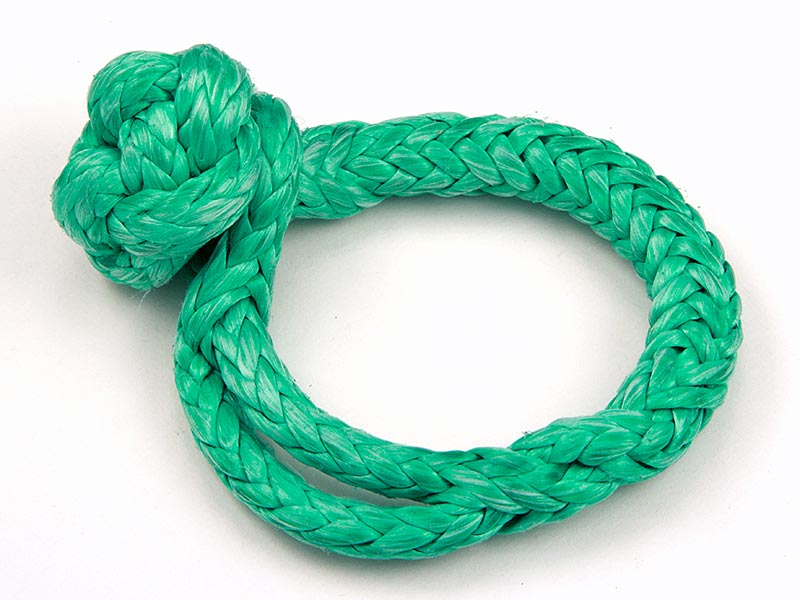You have no items in your shopping cart.
0
You have no items in your shopping cart.
The use of soft shackles in slackline and highline rigging has gotten a lot of attention lately. For this reason, I have been running several tests on various soft shackles and their use in our field. I have found a number of interesting results that I will be sharing with you in a series of articles to come. First, I would like to describe exactly what a soft shackle is, how to make them, and what to do with them.
A soft shackle is a device made from 12-strand rope that forms a closed loop that can be opened via the use of a noose and a big stopper knot.

These devices can be used to connect things together where you would normally use a carabiner, quicklink, or shackle.
The reason soft shackles are awesome is because they are amazingly light. For instance, a 12mm stainless steel bow shackle, which is a common shackle size used in slackline rigging, weighs roughly 120 grams. A soft shackle with the same dimensions as this bow shackle (this size would be stronger than the bow shackle) weighs in at 15 grams. If you think about all the steel connectors you are using in your slackline setup, this has the potential to save you several pounds on your slackline setup.
Some great places to use soft shackles instead of steel shackles are the following:
Please be aware of sharp edges when using soft shackles! Having a severely sharp edge can reduce the strength of a soft shackle by as much as 30%! Repeated use on sharp edges can do even worse damage. If you need to wrap a sharp edge, pad the soft shackle by sleeving it in a piece of tubular webbing or rope sheath.
Soft shackles are available in the BC Shop here: Soft Shackle - 1/4".
Soft shackles are impressively strong. Depending on what material and what size you are using, soft shackles can be as strong or stronger than a steel connector of the same diameter (stock diameter). The various methods of tying soft shackles discussed below all have different strengths. These strengths are shown in "% of single line strength". This means whatever the strength of the material you are using is, this is what percentage of that value your soft shackle will hold, on average. For example, if we were to use 1/4" Amsteel Blue, which has a rated strength of 8,600 lbf and we were to use the Diamond Knot method of tying our soft shackle, we can expect around 136% of the single line strength, or 8,600 * 1.36 = 11,696 lbf.
Remember, the strength values of soft shackles heavily depend on how well you tie your knot and how well the legs of the soft shackle share the load. If you are making your own, take the time to make your knot well and ensure the legs are of proper length!
Also note, the strength values we provide below are a result of a series of tests we ran on soft shackle tying methods. You can read the full results of this test here: Testing Soft Shackles for Weaknesses.
Alright, so now you have some soft shackles, how do you go about using them? There are a few important steps to properly installing your soft shackles to ensure they don't open while under load and hold their rated strength.
Please see this complete guide on using your soft shackles: How to use Soft Shackles
Rightfully so. The fact that soft shackles are made from synthetic material makes them much more prone to damage from abrasion compared to steel or aluminum connectors. If your soft shackles are made from Dyneema 12-strand rope, the damage done by abrasion can easily be assessed (please see the Dyneema article for more information: Dyneema and Slackline Rigging). Check out this chart for determining the damage done to your shackle by abrasion.

If your shackle ever looks anything like a 5 or above, retire it immediately.
Furthermore, to prevent such damage, a great thing to do is sleeve your soft shackles in a protective sheathing. A piece of rope sheath from a large static rope or some of our special Dyneema Shackle Sleeving material works wonderfully. This item will be in the shop very soon.
Here is a video that walks through the soft shackles:
That pretty much covers the overview of soft shackles. If you have any further information or any questions about the above information, please feel free to leave a comment below.
Thanks for reading!
| Product | Price | Quantity | Options | |||||
|---|---|---|---|---|---|---|---|---|
| Features |
| Availability: |
| Price |
| Options |
| Actions |

← Older Post Newer Post →
1 comment
your a legend jerry. thanks for sharing your knowledge!